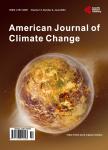Dimethylsulfide and Coral Bleaching: Links to Solar Radiation, Low Level Cloud and the Regulation of Seawater Temperatures and Climate in the Great Barrier Reef
Dimethylsulfide and Coral Bleaching: Links to Solar Radiation, Low Level Cloud and the Regulation of Seawater Temperatures and Climate in the Great Barrier Reef作者机构:School of Environment Science and Engineering Southern Cross University Lismore NSW Australia Marine Ecology Research Centre Southern Cross University Lismore NSW Australia Antarctic Climate and Ecosystems Cooperative Research Centre Hobart Tasmania Australia Centre for Coastal Biogeochemistry Southern Cross University Lismore NSW Australia
出 版 物:《American Journal of Climate Change》 (美国气候变化期刊(英文))
年 卷 期:2017年第6卷第2期
页 面:328-359页
学科分类:1002[医学-临床医学] 100214[医学-肿瘤学] 10[医学]
主 题:Dimethylsulfide Low Level Cloud Climate Feedback Coral Bleaching
摘 要:Coral reefs produce atmospheric dimethylsulfide (DMSa) which oxidises to non-sea-salt (nss) sulfate aerosols, precursors of cloud condensation nuclei (CCN) and low level cloud (LLC), reducing solar radiation and regulating sea surface temperatures (SSTs). Here we report measurements of solar radiation, SST, LLC, DMS flux, , and rainfall before, during and after a major coral bleaching event at Magnetic Island in the central Great Barrier Reef (GBR). Measurements are compared with those made at the nearby fringing reef of Or-pheus Island where coral bleaching did not occur. Extreme solar radiation levels occurred from November to late January and could have reflected cloud radiative effects that increased downwelling of solar radiation. High levels of LLC often coincided with high periodic fluxes of DMS from the unbleached coral reef at Orpheus Island (e.g. 14 - 20 μmol·m-2·d-1), in direct contrast to the very low fluxes of DMS that were emitted from the bleached, human-impacted Magnetic Island fringing reef (nd-0.8 μmol·m-2·d-1) when SSTs were 30°C. Continuous SSTs measurements at the Magnetic Island reef revealed various heating and cooling periods, interspersed with stable SSTs. Cooling periods (negative climate feedback) ranged from -1°C to -3°C (7 day mean -1.6°C), and often seemed to occur during low tides, periodic pulses of DMS flux and LLC, keeping SSTs °C. In contrast warming periods of +1°C to +3°C (positive climate feedback, 7 day mean +1.52°C), seemed to occur during increasing tides, decreasing DMS flux and low to medium levels of LLC which increased solar radiation and caused SSTs over 30°C and corals to bleach. Alternation between these two states or types of feedback is indicated in this research and may be a function of enhanced scattering of solar radiation from nss-sulfate aerosols that originate from oxidation of DMSa produced from the coral reefs in the GBR. The net radiative forcing from clouds can be as high as four times as large as the radi



